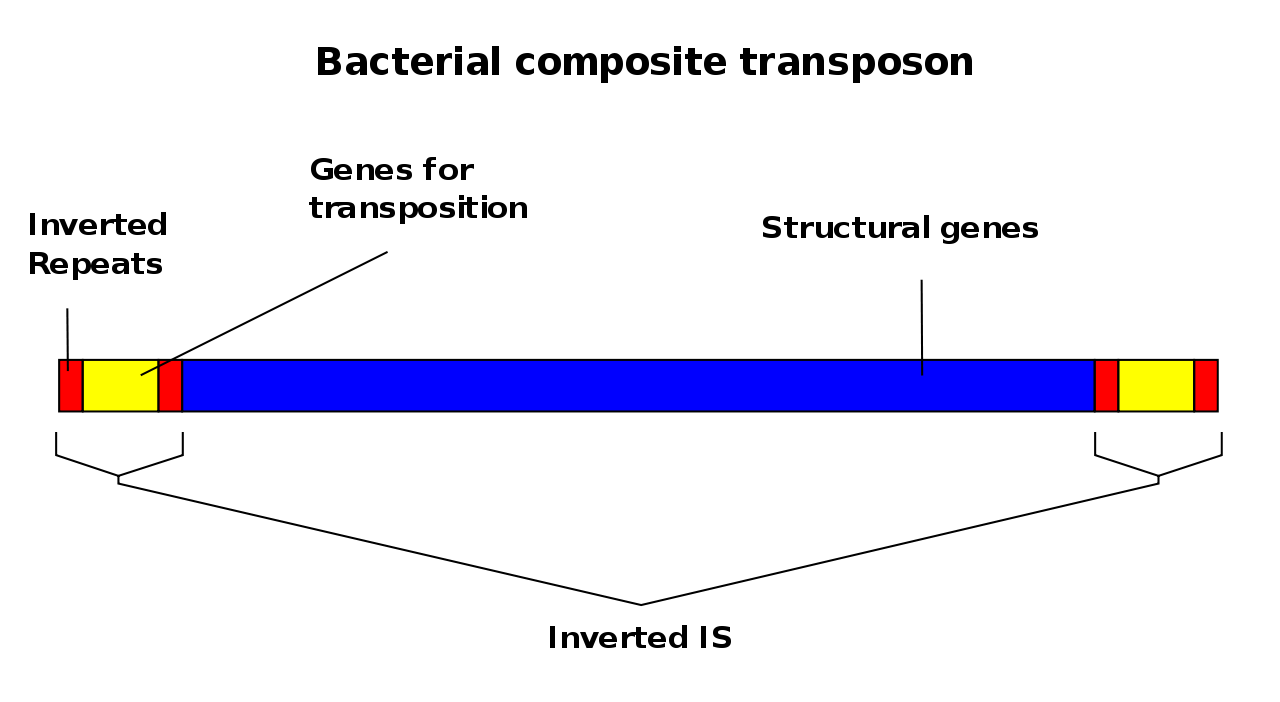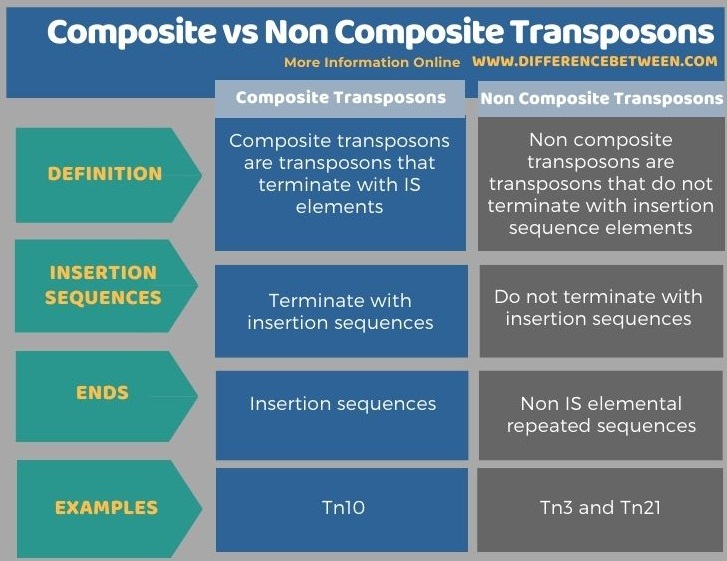The key difference between composite and non composite transposons is that composite transposons have two flanking insertion sequences while non-composite transposons have inverted repeats instead of flanking insertion sequences.
A transposon is a fragment of DNA which can translocate within the bacterial genome. They are mobile DNA sequences. They move into new locations of the genome. These movements make changes in the sequence of the bacterial genome, causing significant changes in genetic information. They are the transposable genetic elements responsible for establishing new genetic sequences in bacteria. Transposons are also referred to as jumping genes because these jumping sequences can block the transcription of genes and rearrange the genetic material of bacterium. Moreover, they are responsible for the movement of drug resistance, antibiotic resistance genes between plasmids and chromosomes. There are two types of transposons as composite and non-composite transposons.
CONTENTS
1. Overview and Key Difference
2. What are Composite Transposons
3. What are Non Composite Transposons
4. Similarities Between Composite and Non Composite Transposons
5. Side by Side Comparison – Composite vs Non Composite Transposons in Tabular Form
6. Summary
What are Composite Transposons?
A composite transposon is a segment of DNA flanked by two copies of similar insertion sequence elements. There is a central protein-coding region in a composite transposon. The genes are often antibiotic-resistant genes. They can also contain catabolic genes. Moreover, composite transposons consist of two inverted repeats.

Figure 01: Composite Transposon
The entire length of the composite transposon moves as one complete unit. Tn10 is a composite transposon. It consists of 6.5 kb central coding region (tetracycline-resistant gene) and 1.4 kb inverted insertion sequence elements at each end.
What are Non Composite Transposons?
Non composite transposons are another type of prokaryotic transposons that do not have insertion sequences flanking at two ends. Similar to composite transposons, non composite transposons have genes coding for antibiotic resistance. Moreover, they contain repeated sequences at their ends. These repeated sequences are needed for transposition. Tn3 is a non composite transposon. Tn3 non composite transposon has three genes at the middle and 38 base pair inverted terminal repeats. Genes in the non composite transposons may code for virulence and catabolic enzymes other than antibiotic resistance. Tn21 is another non composite transposon.
What are the Similarities Between Composite and Non Composite Transposons?
- Both composite and non composite transposons have antibiotic-resistant genes.
- They have inverted repeats as well.
- Moreover, they are mobile DNA segments; hence they can move within the genome.
What is the Difference Between Composite and Non Composite Transposons?
Composite transposons are a type of transposons that have terminal insertion sequence elements and the central coding region. Non composite transposons are a type of transposons that lack flanking insertion sequence elements. They contain only inverted repeats at each end. So, this is the key difference between composite and non composite transposons. Tn10 is a composite transposon while Tn3 and Tn21 are non composite transposons.
Below infographic summarizes the differences between composite and non composite transposons.

Summary – Composite vs Non Composite Transposons
Composite and non composite transposon are two types of prokaryotic transposons. Both types of transposons have a central coding region. However, composite transposons have two flanking inverted insertion sequence elements while non composite transposons do not have flanking insertion sequence elements. Instead, they contain repeated sequences required for transposition. Thus, this is the key difference between composite and non composite transposons. Tn10 is a composite transposon while Tn3 and Tn21 are two non composite transposons. Both types of transposons have genes coding for antibiotic resistance and catabolic enzymes. Moreover, they have terminal inverted repeats.
Reference:
1. “Transposable Genetic Elements In Prokaryotes”. Biology Discussion, 2020, Available here.
2.”Transposons | Learn Science At Scitable”. Nature.Com, 2020, Available here.
Image Courtesy:
1. “Composite transposon” By Jacek FH – self-made, based on Image: Composite transposon.jpg (CC BY-SA 3.0) via Commons Wikimedia
ncG1vNJzZmivp6x7pbXFn5yrnZ6YsqOx07CcnqZemLyue8OinZ%2Bdopq7pLGMm5ytr5Wau26vzqanqKuZqbJurc2dZKennmKwsLnPqKqirJViwbOtzaynqKufo8Bw